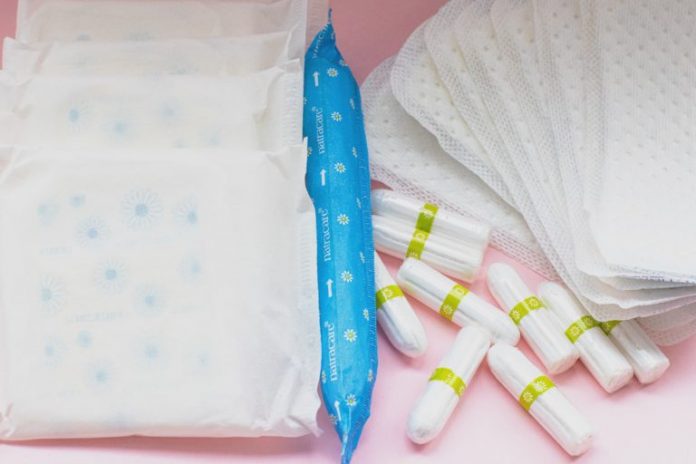
How much menstrual waste does India generate?
A 2018 report by WaterAid India and Menstrual Hygiene Alliance India (MHAI) states that there are 336 million menstruating women in India, out of which only 121 million use sanitary pads. Assuming that these women use eight sanitary pads for one cycle (conservatively), a simple calculation reveals that almost one billion sanitary pads are used and disposed of every year.
The problems with disposal
A majority of menstruators rely on disposable sanitary napkins (DSNs). DSNs are marketed as more hygienic with an increased absorption capacity. The market penetration of DSNs is such that they are synonymous with menstruation. While they are disposable, they are also non-biodegradable. The absorbent core is made of wood pulp, the ‘absorbing gel’ is made of super absorbent polymers, the ‘wings’ have non-biodegradable adhesives to keep them in place, and other materials such as polypropylene and polyethylene are also added. The primary component in all DSN is plastic. This takes approximately 500-800 years to fully disintegrate after disposal. Assuming one billion DSNs are disposed of every year, handling menstrual waste becomes a mammoth task.

How is menstrual waste classified?
Sanitary pads, tampons, and other menstrual hygiene products are categorised as ‘dry municipal waste’ under the Solid Waste Management Rules, 2016. “Dry waste” means waste other than bio-degradable waste and inert street sweepings; it includes recyclable and non-recyclable waste, combustible waste, sanitary napkin and diapers, etc., states the document. The document also states that sanitary waste includes “wastes comprising of used diapers, sanitary towels or napkins, tampons, condoms, incontinence sheets and any other similar waste”. There is ambiguity on whether to consider menstrual waste as biomedical waste or as plastic waste. As the document states, municipal waste is segregated into biodegradable and non-biodegradable components after collection at the waste collection centre. The enormous task of segregation is done manually by the rag pickers who often lack any safety gear.
What is sustainable menstruation?
Various environment advocacy groups have recognised the problems attached to DSNs and their prolonged use. In the past few years, the country has seen a gradual movement towards switching to sustainable and eco-friendly menstrual hygiene products. Menstruators are shifting to using biodegradable sanitary napkins, reusable cloth napkins, menstrual underwear, and menstrual cups. Biodegradable sanitary napkins can decompose in six to 12 months. Reusable cloth pads and menstrual underwear can be reused for a year or two. Menstrual cups are made of medical-grade silicon and are reusable for five to 10 years.
“Compared to the scenario that was prevalent six years ago, the awareness towards menstruation and menstrual products has increased manifold. If I talked about menstrual cups six years ago, I would have been met with inquisitiveness and curious eyes. The awareness has increased in society although menstruators are hesitant on making a switch. I believe this will be a gradual process,” said Anju Arora, co-founder of The Period Hub. The organization has been instrumental in empowering menstruators in Hyderabad and the nearby villages of Telangana.
“Switching to eco-friendly sanitary napkins and cloth napkins is a natural progression for most menstruators. Prolonged use of plastic-based DSNs has resulted in rashes, itching, skin sensitivity, and burning for many, leading to an uncomfortable experience. The artificial fragrance used in DSNs to make them more appealing has an opposite effect. Most menstruators find the smell to be nausea-inducing”, said Dimple Kour, founder of Anubhuti Shree Foundation, based in Bhilai, Chattisgarh. The foundation aims at empowering menstruators who hail from the marginalized communities in Chattisgarh, Jharkhand, and Madhya Pradesh.
“Period poverty”
According to the National Family Health Survey-4 (which is a representative study) held in 2015-16, among women aged 15-19, only 57.7% used hygienic menstrual measures. Furthermore, in women aged 20-24, the number fell to 57.4%. Women not fortunate enough to afford sanitary napkins and other hygienic menstrual hygiene products use rags, ash, plastic, or even sand as alternatives.
In July 2018, the Central Government implemented tax exemptions on sanitary pads and tampons. A welcome move, this made menstrual hygiene products more accessible and affordable to a lot of menstruators. But this also added to the growing problem of managing menstrual waste arising from DSNs. “With tax exemptions, DSNs became more affordable. There should be exemptions on reusable menstrual products too so that more and more menstruators can make the shift,” added Arora.
“I promote the use of cloth in my menstrual awareness sessions. Using a cloth is very similar to using reusable cloth pads. The problem does not lie in cloth but in the wrong use of that. We educate menstruators on how this is nothing to be shameful of. We teach them to wash it in warm water and let it dry in direct sunlight. A simple pack of three reusable cloth pads costs around Rs. 160 which is unaffordable for many,” said Janvi Tiwari, co-founder of Menses with Manasa, based in Bhopal, Madhya Pradesh.
Period poverty, as Menses with Manasa puts it, hinders menstruators from adopting hygienic alternatives. Period poverty is the inability to afford hygienic menstrual products thereby leading to decreasing menstrual health management in low-income areas.
What can consumers — and producers — do?
The Solid Waste Management Rules 2016 lays down rules for both producers and consumers of non-biodegradable products. Under the Clause 4 duties of waste generators, consumers should “wrap securely the used sanitary waste like diapers, sanitary pads, etc. in the pouches provided by the manufacturers or brand owners of these products, or in a suitable wrapping material as instructed by the local authorities, and shall place the same in the bin meant for dry waste or non-bio-degradable waste.”
Similarly, as per Rule 17 under the duty of manufacturer or brand owners, they “shall explore the possibility of using all recyclable materials in their products or they shall provide a pouch or wrapper for disposal of each napkin or diapers along with the packet of their sanitary products.”
This practice, however, is not as widespread and often the packet to seal individual sanitary napkins itself if too flimsy to appropriately hold the waste product.

The disposed of material is further segregated by the waste segregators at the waste collection centre. As only flimsy packets are provided, the consumers themselves do not take the onus to wrap the soiled DSN carefully before disposal.
“Through my groundwork with safai-karmacharis (cleaning staff), they have always complained how they end up segregating used pads which are not even wrapped properly. People forget their dignity of labour. They forget that after throwing the pads, someone else has to segregate each waste by hand. They have complained how the smell and sight makes them nauseous,” said Kour.
Ways to empower the waste pickers
Experts state how exposure to poorly discarded DSNs can expose the workers to a variety of bacteria and illness. In Pune, to combat this, the Pune Municipal Corporation collaborated with SWaCH, a waste-picker cooperative, to start the Red Dot Campaign. Under this, households should wrap and mark their sanitary waste with a red dot before disposal. SWaCH reported that 50% of their customers were wrapping and marking their sanitary waste, compared with 0% before the campaign began. Campaigns like this give waste pickers self-advocacy and return their dignity of labour.
Throughout the Solid Waste Management Rules 2016, the government has laid down methods of disposing of menstrual waste. These include “disposal deep burial, composting, pit burning, and incineration.” There is a push for incineration but within the specified limits.
A study by the Quantum Hub, a public policy research and advocacy, in collaboration with the National Faecal Sludge and Septage Management (NFSSM) Alliance, states that “the incinerator must burn waste at a temperature that is at least higher than 800 degrees Celsius, in contrast, the CPCB Guidelines on Sanitary Waste prescribe a temperature of only 300 degree Celsius.”
Arora said, “Most large-scale incinerators are outside city limits. There is no existing organised chain of this. Incineration has its disadvantages too.”
The way ahead
The future of sustainable menstruation lies in breaking taboos and empowering menstruators. In her sessions with young menstruators in government schools, Tiwari and her team “educate them and make them aware of their bodies. We break taboos and customs by adding scientific facts and logic. We teach them not to dispose of pads in water bodies.”
The path to making sustainable menstruation a reality is slow but not impossible.
This article has been authored by Snigdha Nalini Oreya. The article originally appeared in Mongabay.












